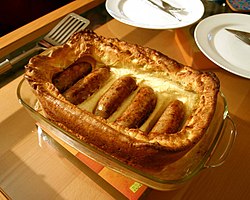COMPETENCES
-Competence in linguistic and audiovisual communication
-Artistic and cultural competence
-Competence in using ICT
-Learning to learn
-Autonomy and personal initiative competence
CONTENTS
-New vocabulary acquisition: baked beans, black pudding, hash brown, Yorkshire pudding, "a cuppa", "coach potato", beef stew, etc...
-Present Simple & daily routines.
AIMS
-Remember & acquire new food vocabulary.
-Learn to express yourself and to get the message across in English
-Improve your listening skills
-Acknowledge different cultures, habbits and traditions
-Search new vocabulary on the net
Session 1: (LISTENING & SPEAKING)
A) ENGLISH BREAKFAST:
-Brainstorming: Warm up activity: try to find the name of different kinds of food that British people eat for breakfast. (Students should be able to mention most of these words: tea, coffee, orange juice, toasts, cereal, bacon, baked beans, sausages, mushrooms, hash browns, fried egg, fried tomato, black pudding, ketchup).
Have a look at this video:
 There's nothing more typically British than "a nice hot cup of tea" or " a cuppa"!
There's nothing more typically British than "a nice hot cup of tea" or " a cuppa"!ANSWER THESE QUESTIONS: -Why is English breakfast good for you?
-Where abouts in England is she in?
Students might not know the meaning of the following ingredients so please, assist them with this information on wikipedia:
http://en.wikipedia.org/wiki/Hash_browns
http://en.wikipedia.org/wiki/Black_pudding
B) SPANISH BREAKFAST
Would you consider these are the most common and stereotypical Spanish breakfasts? Why?
Have a look at the following video:
ANSWER THE FOLLOWING QUESTIONS:
-What time do Spanish people usually have breakfast?
-What's the word used in English for "café solo"?
-What kind of oranges are used for a freshly made orange juice?
-What's the main ingredient on a toast?
COMPARE:
-Which breakfast do you think is healthier? Why?
-Do English people have breakfast at the same time as Spanish people?
-What do you usually have for breakfast? Ask your partner.
-Do you drink tea, coffe, orange juice, milk, Cola Cao for breakfast?
C) HAVE SOME FUN!
LONDON'S FUNNIEST SKYLINE! A must see! (Work in groups of 4)
-Pay close attention to London's skyline. What can you see?
-One by one, analyse every single detail in each picture. What vegetables can you see?
http://seawayblog.blogspot.com/2009/11/londons-skyline-has-never-been-more.html
-Go to the end of the blog and read through the text. You will see what London's most famous buildings are made of!
Session 2: (READING & WRITING).
-Have a look at the following link from a popular restaurant in London. In this link you will find a list with their daily special dishes. http://www.porters.uk.com/Menus.aspx?id=11
-Likewise, have a look at the following link from a restaurant in Madrid. In this case, you will find a list with their main dishes: http://www.restaurante-sierra-madrigal.com/cartas.php
ACTIVITIES:
A) Find the meaning of those dishes / food / ingredients you do not understand from the English menu. For example, what do "Yorkshire Pudding", "Mashed Potato" and "Beef Stew" mean? Find others.
Useful sites to help you with the new vocabulary:
http://www.wikipedia.org/, http://www.wordreference.com/
Have a look at the following picture:

This is one of the special dishes from the Porter's restaurant. How would you describe it? What's the name of the dish?
B) After having analysed carefully both menus, CREATE and WRITE your own menu using dishes from the English and the Spanish sites. Explain why you are choosing these dishes and explain in detail their main ingredients. (150-200 words).
C) HAVE SOME FUN!
For Fast Finishes: Have a look at the following pictures:
-What do these pictures suggest?
-What do they have in common?
-Are you familiar with the expression "be a couch potato"? What does it mean? Find it!
No hay comentarios:
Publicar un comentario